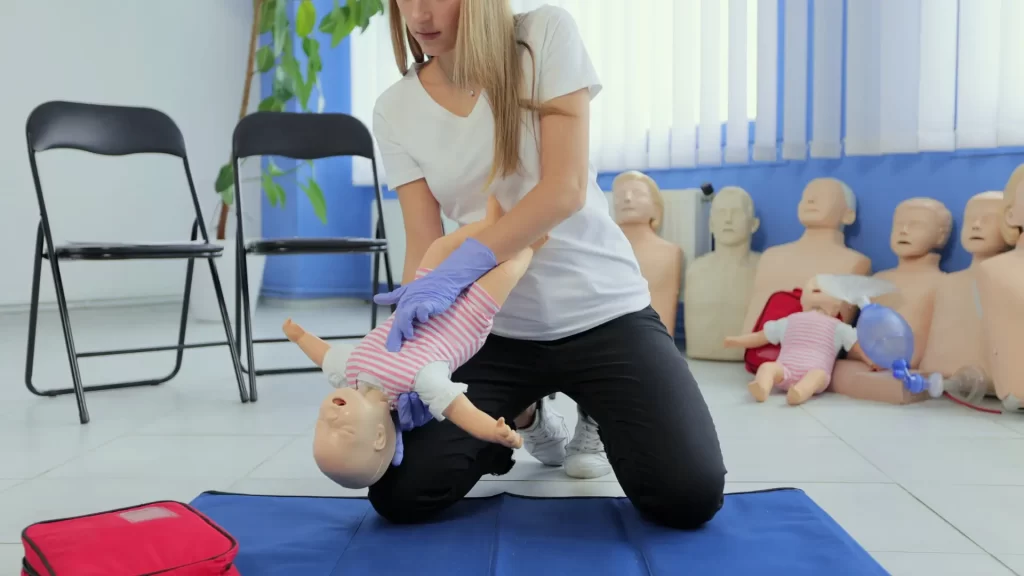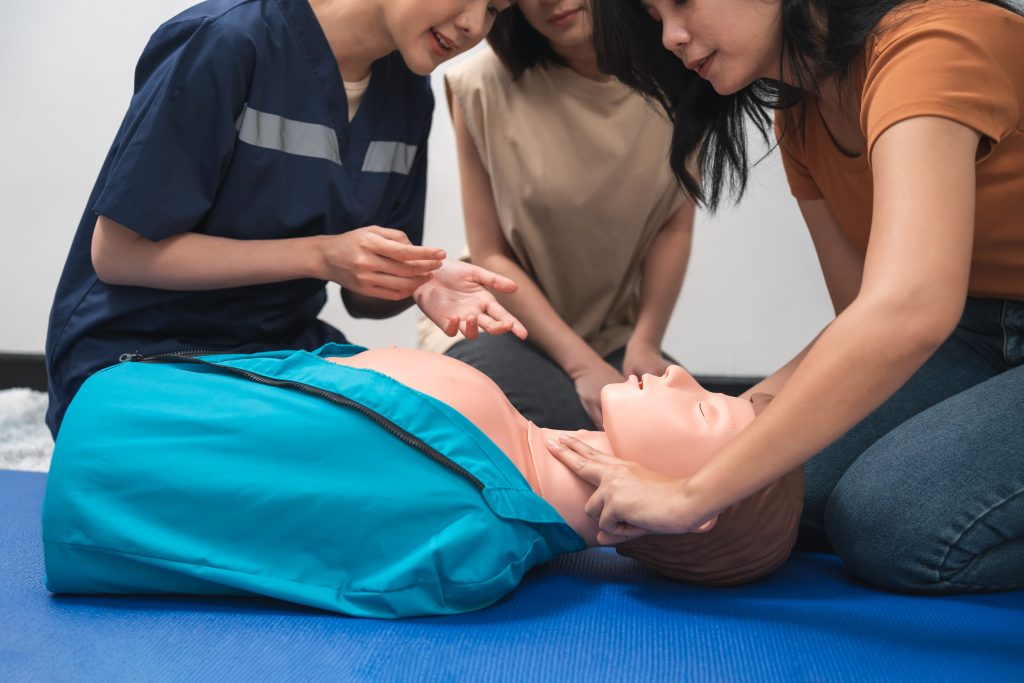
Imagine you’re enjoying a meal at one of Austin’s fantastic restaurants. Suddenly, someone at a nearby table starts to struggle, clutching their throat. A moment of panic sets in. What do you do? This isn’t just a scene from a movie; it’s a real-life emergency that happens more often than you might think. Knowing how to respond can be the difference between life and death.
Choking is a critical medical emergency where a person’s airway is blocked, either partially or completely, by a foreign object. It’s an issue that can affect anyone, regardless of age, and requires an immediate and decisive response. The seconds that follow are crucial. While paramedics are on their way, the actions of a bystander, someone like you, are the first and most vital link in the chain of survival. This guide will walk you through the essential steps to take during a choking emergency right here in Austin, TX.
Understanding the Signs of Choking
Recognizing a choking emergency is the first step toward providing help. The signs can vary, but there are some common indicators you should look for. A person who is mildly choking may still be able to cough forcefully or speak. This is a sign of a partial airway obstruction, and you should encourage them to continue coughing, as this is often the most effective way to clear the blockage. However, a severe, or complete, airway obstruction is a much more serious situation.
A person with a severe airway obstruction cannot speak, cough, or breathe. They may make high-pitched noises or no sound at all. Their face may turn blue or gray, a condition known as cyanosis, due to a lack of oxygen. The universal sign for choking, which is a person clutching their throat with one or both hands, is a clear signal that something is wrong. In an emergency, every second counts. Your immediate action can prevent a tragic outcome.

The Life-Saving Heimlich Maneuver (Abdominal Thrusts)
The Heimlich maneuver, also known as abdominal thrusts, is the standard first-aid procedure for an adult or child who is severely choking. It’s a series of quick, upward pushes to the abdomen designed to create an artificial cough that can dislodge the object. The technique is a powerful tool in your first-aid arsenal, but it must be performed correctly to be effective and safe.
To perform the Heimlich maneuver on an adult, first, stand behind the person and wrap your arms around their waist. Make a fist with one hand and place it just above their navel. Grasp your fist with your other hand. Deliver five quick, upward thrusts into the person’s abdomen. The goal is to create a forceful pressure that pushes the object out of their airway. Continue these thrusts until the object is dislodged or the person becomes unresponsive.
If you are alone and choking, you can perform the Heimlich maneuver on yourself. Make a fist with one hand and place it above your navel. Grab your fist with your other hand. Then, lean over a firm object, such as a countertop or chair, and thrust your abdomen against it. This self-help technique can be a lifesaver when no one else is around to assist.
Adjusting Your Approach for Pregnant Women and Obese Individuals
Standard abdominal thrusts can be dangerous for a pregnant woman or a person who is obese. In these cases, you should use chest thrusts instead. To perform chest thrusts, stand behind the person and place your arms under their armpits, wrapping them around their chest. Place the thumb side of your fist on the center of the breastbone. Grab your fist with your other hand. Deliver five quick inward and firm thrusts. Continue these thrusts until the object is dislodged or the person becomes unresponsive.
This modified technique provides a safer way to create the necessary force to dislodge the object without causing injury to the person or, in the case of a pregnant woman, the fetus. It’s an essential adaptation to the standard Heimlich maneuver that everyone should be aware of, as you never know when you might need to help someone with a unique physical condition. Knowing the right technique is just as important as knowing how to react.
Choking in Infants: A Delicate and Urgent Situation
A choking emergency in an infant requires a different set of techniques. The tiny airways of babies are easily obstructed, and their fragile bodies must be handled with care. If you suspect an infant is choking, first look inside their mouth for the object. If you can see it, try to sweep it out carefully with one finger, but be cautious not to push it further down the throat. If you cannot see the object, or cannot remove it, you must proceed with back blows and chest thrusts.
Hold the infant face down along your forearm with their head lower than their chest. Support the infant’s head and neck with your hand. Deliver five quick and firm back blows between their shoulder blades using the heel of your hand. After the back blows, turn the infant face up on your other forearm. Place two fingers on the center of their chest, just below the nipple line. Deliver five quick and firm chest thrusts. Continue alternating between five back blows and five chest thrusts until the object is dislodged or the infant becomes unresponsive.
Remember, never perform abdominal thrusts on an infant as this can cause severe injury. The combination of back blows and chest thrusts is the safest and most effective method for clearing an infant’s airway. The ability to perform this technique confidently and correctly is a truly invaluable skill. It’s an act of love and care that can save a life.
When to Begin CPR
A choking emergency can escalate quickly. If a person, whether an adult, child, or infant, becomes unresponsive, their body has been deprived of oxygen for too long. At this point, the next step is to begin CPR. You should also call 911 or have someone else do so immediately. The first-aid response for choking transitions from clearing the airway to supporting life functions.
To begin CPR on an unresponsive choking victim, start with chest compressions. The goal is to circulate oxygenated blood to the brain and other vital organs. You should perform high-quality chest compressions at a rate of 100 to 120 compressions per minute. After 30 compressions, open the person’s airway and look for the object. If you see it, remove it. If not, give two rescue breaths. Continue this cycle of 30 compressions and two breaths until emergency medical services arrive or the person begins to show signs of life.
The transition from choking relief to CPR is a critical one. It highlights the interconnectedness of first-aid skills. Your ability to provide immediate and appropriate care is paramount. It’s why certified training is so important. A CPR-certified individual understands not only how to perform these techniques but also when to use them and how to seamlessly move from one to the next as the situation demands.

The Importance of Professional CPR Certification
While reading this guide gives you a foundational understanding of choking relief techniques, nothing replaces the hands-on training and expert guidance you receive from a professional CPR certification course. In a controlled class setting, you can practice these life-saving skills on manikins, gaining the muscle memory and confidence required to act decisively in a real-world emergency. An instructor can provide real-time feedback, ensuring you are performing each technique correctly.
CPR classes cover more than just choking relief. They teach you how to recognize and respond to cardiac arrest, stroke, and other medical emergencies. They provide you with a comprehensive skill set that can empower you to become a true first responder in your community. A certification card is more than just a piece of paper; it’s a symbol of your commitment to helping others and a testament to your ability to remain calm and effective under pressure.
Being prepared to act in an emergency isn’t just about knowing what to do; it’s about having the confidence to do it. A CPR certification gives you that confidence. In Austin, TX, there are many opportunities to get certified and learn these vital skills. Don’t wait until an emergency happens to wish you were prepared.
Conclusion
Knowing what to do when a person is choking is a vital skill. Whether it’s a family member, a friend, or a stranger, your immediate and correct action can change the course of an emergency. This guide has provided you with the foundational knowledge of choking relief techniques for adults, children, and infants. However, real-world proficiency comes from hands-on training.
Don’t just be a witness to an emergency; be the person who can step in and make a difference. Taking a CPR certification course will empower you with the skills and confidence to act decisively. If you live in or around Austin, now is the perfect time to get certified.
Are you ready to learn these life-saving skills? Contact CPR Classes Near Me today to schedule your certification course and become a life-saver in your community.
Frequently Asked Questions (FAQ)
Q: What is the most common cause of choking?
A: The most common cause of choking is a foreign object, typically food, that becomes lodged in the throat or windpipe, blocking the flow of air. For adults, this often occurs while eating or drinking. For children and infants, choking can be caused by small toys, coins, or other household items.
Q: How do I know the difference between a mild and a severe choking emergency?
A: A person with a mild airway obstruction can still cough forcefully and may be able to speak. You should encourage them to keep coughing to try and clear the obstruction on their own. A person with a severe airway obstruction cannot cough, speak, or breathe. They may also turn blue in the face and make high-pitched noises or no sound at all. This is when immediate intervention is needed.
Q: Is it safe to perform the Heimlich maneuver on a pregnant woman?
A: No, the standard Heimlich maneuver (abdominal thrusts) is not recommended for pregnant women or obese individuals as it can cause injury. Instead, you should perform chest thrusts. This involves wrapping your arms around the person’s chest and delivering quick, inward thrusts to their breastbone until the object is dislodged or they become unresponsive.
Q: When should I start CPR on a choking victim?
A: You should begin CPR immediately if the choking victim becomes unresponsive. This indicates that they are no longer breathing, and their heart may have stopped. Call 911 immediately and begin chest compressions and rescue breaths. Continue this until emergency medical services arrive or the person shows signs of life.
Q: Where can I get CPR certified in Austin, TX?
A: You can get CPR certified by taking a professional course. These classes are offered by various organizations and provide hands-on training with expert instructors. To find a class near you, simply search for “CPR Classes Near Me” and contact a reputable provider to schedule your training.

Leave a Reply